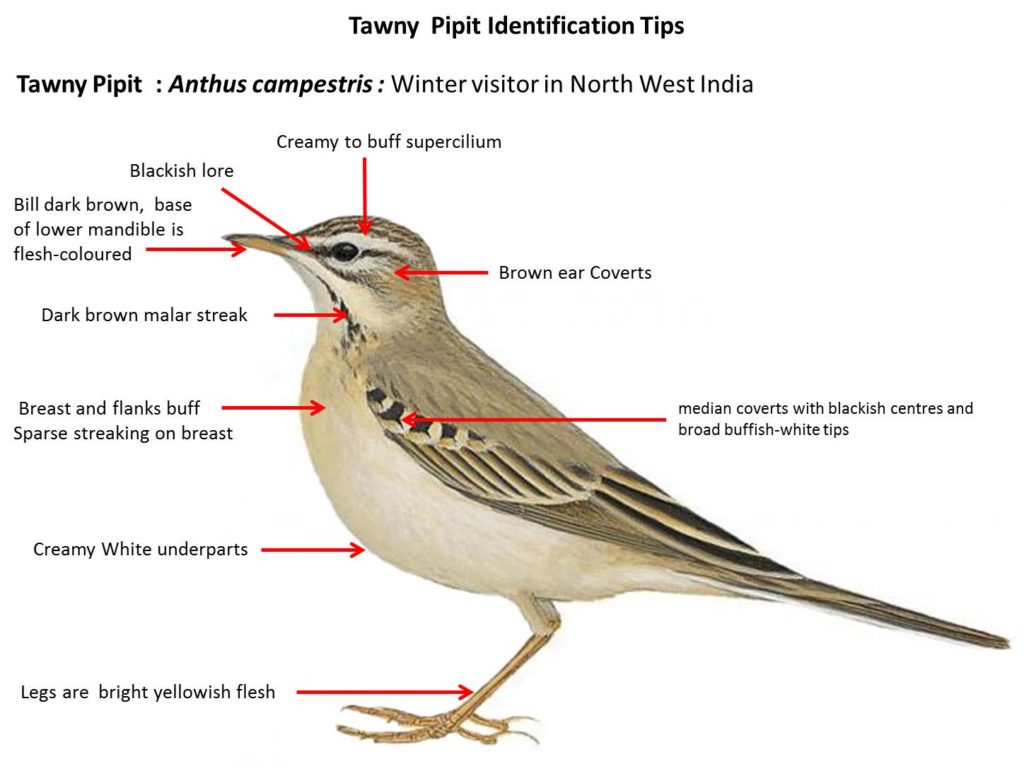Tawny Pipit

Tawny Pipit Anthus campestris
Etymology
- Anthus : Based on Greek mythology. Anthus, son of Antinous and Hippodamia, was killed by his father’s horses and metamorphosed into a bird which imitated the neighing of horses but fled at their sight
- Campestris: Latin word for of the field derived from campi- field
Vernacular Names:Hindi: Chillu, Pilashvalidhanchidi, Pun: Baggicharchari, Mar: PingatTirchimany
Distribution in India: Winter visitor in North WestIndia.
Description:
Size of 16·5–17 cm; wt. of 17–32 g. It is a fairly distinctive pipit with uniform plumage, long tail and wagtail like stance. The nominate race has prominent creamy or buffish supercilium, blackish loral and moustachial stripes; lores and ear-coverts are brown with creamy flecks. It has distinct, narrow dark brown malar streak; pale sandy brown above, sometimes with greyish tinge, indistinctly streaked blackish-brown, the back and rump are unmarked. The flight-feathers and primary coverts dark brown with narrow white edges, tertials and greater wing-coverts are paler with broad sandy-buff edges and tips, median coverts have blackish centres and broad buffish-white tips, lesser coverts are sandy brown. The tail is blackish-brown, central feather pair is edged pale buff or buffy rufous, outer two pairs have pale buff wedges on inner web, white outer web and much of distal inner web. It is creamy white below, breast and flanks are buff, breast with sparse short dark brown streaks; underwing-coverts and axillaries are creamy buff; iris is blackish-brown; bill is dark brown, flesh-coloured base of lower mandible; legs are bright yellowish flesh. . Both the sexes are alike. The juvenile is scalloped or strongly streaked above, with tawny feather edges; median coverts edged and tipped whitish, forming more obvious wingbar, upper breast are sharply streaked.
Habitat: It is found in dry habitats, from sand dunes, sandy heaths, dry grassland and clear-felled areas to artificial habitats such as gravel pits and steppe and semi-deserts. It is found from lowlands 3600 m.
Food habits: It eats insects, invertebrates, small vertebrates and seeds. The prey include grasshoppers and locusts ,termites , dragonflies and damselflies, mantids, adult and larval butterflies and moths, lacewings, flies, sawflies and ants, beetles and bugs, spiders, harvestmen, slugs and snails. It forages mainly on the ground, by running and pecking. It jumps up to take flying insects, such as termites and only rarely flies after prey, or hovers to find it. It will stand on large items such as a grasshoppers, and dismember these by hammering with the bill.
Breeding habits: They breed in Apr to Aug in N Africa, Jun in Sweden and May to Jul in Central Europe.they are monogamous and territorial. In display-flight, rises high up, sings while circling randomly on deeply undulating course; descent steep, or gliding and angled, sometimes with continued song. The nest is built mainly by female, sometimes helped by male. The nest is a cup of grass stems, leaves and roots, lined with finer plant material and hair, built in scrape or hollow on ground or in tuft of grass. They lay a clutch of 3–6 eggs. The incubation is done by female and sometimes by both sexes. The incubation period is 11–14 days. The nestlings are fed by both parents, for 13–14 days. The post-fledging care is also by both parents, for 4–5 weeks.